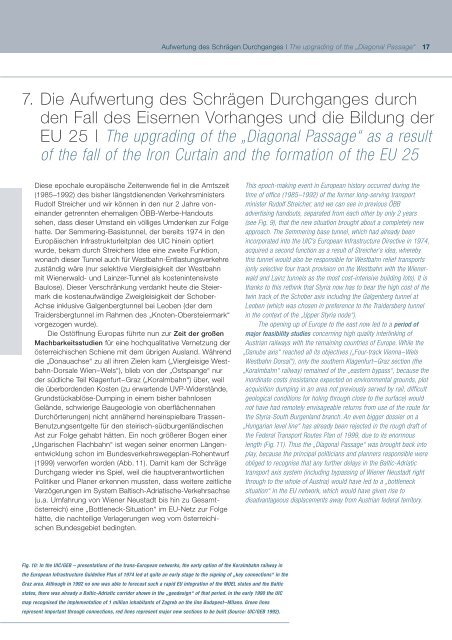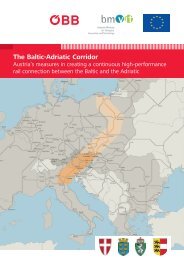Inhalt | Contens - baltic-adriatic.eu
Inhalt | Contens - baltic-adriatic.eu
Inhalt | Contens - baltic-adriatic.eu
Sie wollen auch ein ePaper? Erhöhen Sie die Reichweite Ihrer Titel.
YUMPU macht aus Druck-PDFs automatisch weboptimierte ePaper, die Google liebt.
Diese epochale <strong>eu</strong>ropäische Zeitenwende fiel in die Amtszeit<br />
(1985–1992) des bisher längstdienenden Verkehrsministers<br />
Rudolf Streicher und wir können in den nur 2 Jahre voneinander<br />
getrennten ehemaligen ÖBB-Werbe-Handouts<br />
sehen, dass dieser Umstand ein völliges Umdenken zur Folge<br />
hatte. Der Semmering-Basistunnel, der bereits 1974 in den<br />
Europäischen Infrastrukturleitplan des UIC hinein optiert<br />
wurde, bekam durch Streichers Idee eine zweite Funktion,<br />
wonach dieser Tunnel auch für Westbahn-Entlastungsverkehre<br />
zuständig wäre (nur selektive Viergleisigkeit der Westbahn<br />
mit Wienerwald- und Lainzer-Tunnel als kostenintensivste<br />
Baulose). Dieser Verschränkung verdankt h<strong>eu</strong>te die Steiermark<br />
die kostenaufwändige Zweigleisigkeit der Schober-<br />
Achse inklusive Galgenbergtunnel bei Leoben (der dem<br />
Traidersbergtunnel im Rahmen des „Knoten-Obersteiermark“<br />
vorgezogen wurde).<br />
Die Ostöffnung Europas führte nun zur Zeit der großen<br />
Machbarkeitsstudien für eine hochqualitative Vernetzung der<br />
österreichischen Schiene mit dem übrigen Ausland. Während<br />
die „Donauachse“ zu all ihren Zielen kam („Viergleisige Westbahn-Dorsale<br />
Wien–Wels“), blieb von der „Ostspange“ nur<br />
der südliche Teil Klagenfurt–Graz („Koralmbahn“) über, weil<br />
die überbordenden Kosten (zu erwartende UVP-Widerstände,<br />
Grundstückablöse-Dumping in einem bisher bahnlosen<br />
Gelände, schwierige Baugeologie von oberflächennahen<br />
Durchörterungen) nicht annähernd hereinspielbare Trassen-<br />
Benutzungsentgelte für den steirisch-südburgenländischen<br />
Ast zur Folge gehabt hätten. Ein noch größerer Bogen einer<br />
„Ungarischen Flachbahn“ ist wegen seiner enormen Längenentwicklung<br />
schon im Bundesverkehrswegeplan-Rohentwurf<br />
(1999) verworfen worden (Abb. 11). Damit kam der Schräge<br />
Durchgang wieder ins Spiel, weil die hauptverantwortlichen<br />
Politiker und Planer erkennen mussten, dass weitere zeitliche<br />
Verzögerungen im System Baltisch-Adriatische-Verkehrsachse<br />
(u.a. Umfahrung von Wiener N<strong>eu</strong>stadt bis hin zu Gesamtösterreich)<br />
eine „Bottleneck-Situation“ im EU-Netz zur Folge<br />
hätte, die nachteilige Verlagerungen weg vom österreichischen<br />
Bundesgebiet bedingten.<br />
Aufwertung des Schrägen Durchganges | The upgrading of the „Diagonal Passage“ 17<br />
7. Die Aufwertung des Schrägen Durchganges durch<br />
den Fall des Eisernen Vorhanges und die Bildung der<br />
EU 25 | The upgrading of the „Diagonal Passage“ as a result<br />
of the fall of the Iron Curtain and the formation of the EU 25<br />
Fig. 10: In the UIC/GEB – presentations of the trans-European networks, the early option of the Koralmbahn railway in<br />
the European Infrastructure Guideline Plan of 1974 led at quite an early stage to the signing of „key connections“ in the<br />
Graz area. Although in 1992 no one was able to forecast such a rapid EU integration of the MOEL states and the Baltic<br />
states, there was already a Baltic-Adriatic corridor shown in the „geodesign“ of that period. In the early 1990 the UIC<br />
map recognised the implementation of 1 million inhabitants of Zagreb on the line Budapest–Milano. Green lines<br />
represent important through connections, red lines represent major new sections to be built (Source: UIC/GEB 1992).<br />
This epoch-making event in European history occurred during the<br />
time of office (1985–1992) of the former long-serving transport<br />
minister Rudolf Streicher, and we can see in previous ÖBB<br />
advertising handouts, separated from each other by only 2 years<br />
(see Fig. 9), that the new situation brought about a completely new<br />
approach. The Semmering base tunnel, which had already been<br />
incorporated into the UIC’s European Infrastructure Directive in 1974,<br />
acquired a second function as a result of Streicher’s idea, whereby<br />
this tunnel would also be responsible for Westbahn relief transports<br />
(only selective four track provision on the Westbahn with the Wienerwald<br />
and Lainz tunnels as the most cost-intensive building lots). It is<br />
thanks to this rethink that Styria now has to bear the high cost of the<br />
twin track of the Schober axis including the Galgenberg tunnel at<br />
Leoben (which was chosen in preference to the Traidersberg tunnel<br />
in the context of the „Upper Styria node“).<br />
The opening up of Europe to the east now led to a period of<br />
major feasibility studies concerning high quality interlinking of<br />
Austrian railways with the remaining countries of Europe. While the<br />
„Danube axis“ reached all its objectives („Four-track Vienna–Wels<br />
Westbahn Dorsal“), only the southern Klagenfurt–Graz section (the<br />
„Koralmbahn“ railway) remained of the „eastern bypass“, because the<br />
inordinate costs (resistance expected on environmental grounds, plot<br />
acquisition dumping in an area not previously served by rail, difficult<br />
geological conditions for holing through close to the surface) would<br />
not have had remotely envisageable returns from use of the route for<br />
the Styria-South Burgenland branch. An even bigger dossier on a<br />
„Hungarian level line“ has already been rejected in the rough draft of<br />
the Federal Transport Routes Plan of 1999, due to its enormous<br />
length (Fig. 11). Thus the „Diagonal Passage“ was brought back into<br />
play, because the principal politicians and planners responsible were<br />
obliged to recognise that any further delays in the Baltic-Adriatic<br />
transport axis system (including bypassing of Wiener N<strong>eu</strong>stadt right<br />
through to the whole of Austria) would have led to a „bottleneck<br />
situation“ in the EU network, which would have given rise to<br />
disadvantageous displacements away from Austrian federal territory.



